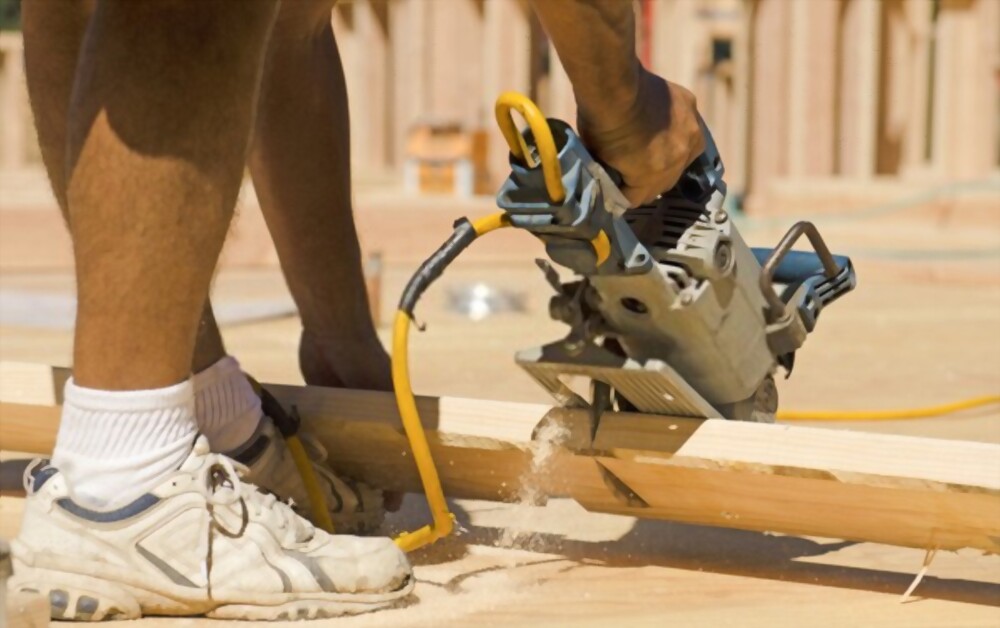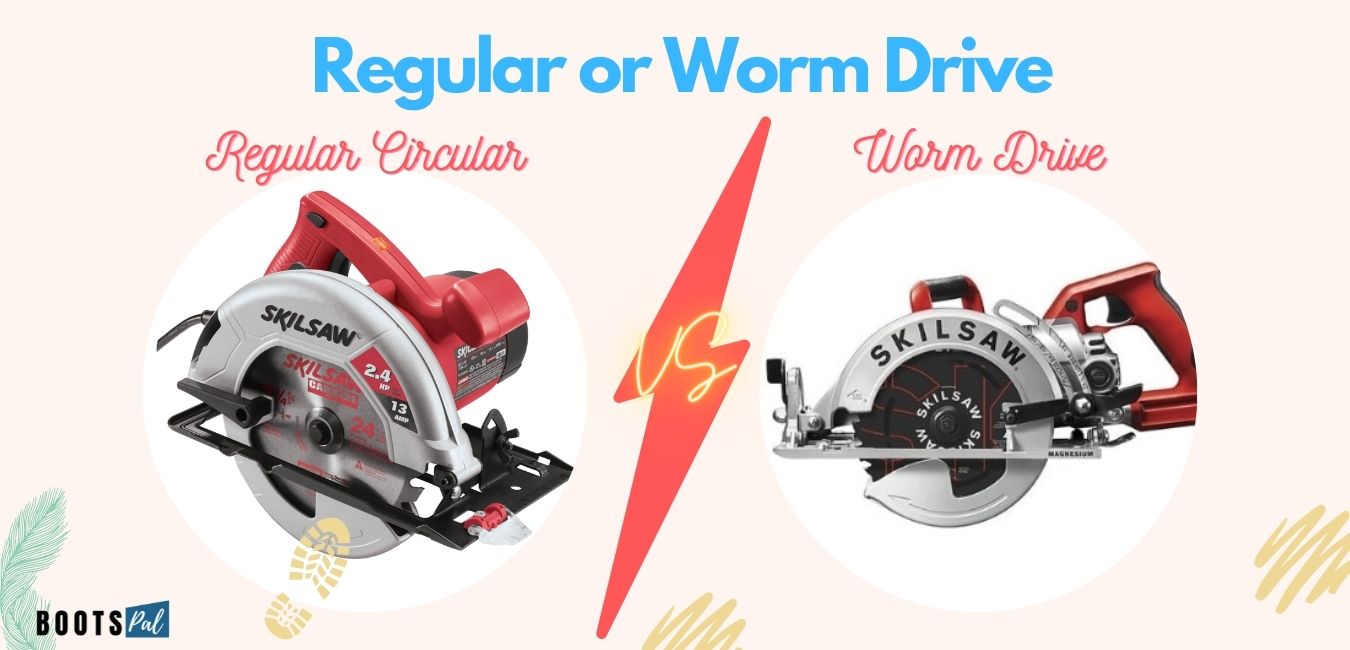Are you confused between worm drive circular saw vs regular saw as both looks almost the same? Well, dig some more and you will find eye-opening differences between the two types.
Let alone the beginner, even a lot of professionals don’t know about them deeply and keep struggling with the wrong tool. If you are trying to cut heavy and thick boards with a regular circular saw, our condolences are with you.
So, don’t just take shots in the dark and know more about sidewinder vs. worm drive saw.
Here, the following parameters will help you choose the right one, i.e. Worm drive or Regular Direct Drive Circular saw for the task:
- Mechanical Difference
- Power output
- Maintenance
- Handling
- Weight
- Preference
- Cost
What is a Worm Drive on a Circular Saw?

Worm drive on a circular saw means that it has a motor connected to the blade by a worm gear.
A worm gear consists of two parts where one is called worm screw and another is worm wheel.
As you can see one in the picture, this allows the motor of the circular saw to be placed just behind the blade parallelly.
So, why is it called a worm drive?
It is called worm drive because of the meaning of the word ‘worm’. In a mechanical dictionary, it means something spiral and the screw-shaped top part has spiral linings.
That’s all about worm drive and a thorough discussion on worm drive saw vs. direct drive saw is the next item on the menu.
Worm Drive Circular Saw vs Regular Saw
The following criterion will give you a proper idea about the differences between a worm drive and a regular circular saw.
Mechanical Difference

The first big and most important difference is in the mechanism of both types. A regular circular saw has a design where the motor is placed beside the blade. Or you can say they are perpendicular to each other, and the motor is directly connected to the blade. That is the reason it is called a direct-drive or sidewinder circular saw.
On the other hand, a worm drive saw has a mechanical design where the motor is right behind the blade. So, instead of connecting directly, the motor and the blade is connected by a worm gear.
Power output

Because of the mechanical difference of those saw types, there is an output power difference. But first, you have to understand two things where one is RPM and another is Torque.
RPM means Rotations Per Minute and it resembles the blade’s rotating speed in this matter. Torque, however, means how smoothly a saw can cut large and thick pieces. Rotations can be limited but techniques can be applied to increase the torque of a device.
Now, let’s get back to the discussion we were having. The facts are that regular circular saw has average speed of 6000 RPM and worm drive saw provides around 4500 RPM. But the torque is higher in the worm drive because of the worm gear mechanism.
For powerful cutting, low RPM and high torque is the clear winner and worm drive can get serious industrial projects done. High RPM and low torque provided by a sidewinder saw are perfect for mid-range tasks and DIY projects.
As we are focusing on powerful and deep cutting capabilities, you should also know about miter saw. Reading circular saw vs. miter saw can help you get an idea about another useful tool.
Getting into Tight Spaces
You know how one needs to improvise to make crafts and work in tight spaces. In many situations, you would wish if you had a tool to do the cut. A worm drive circular saw is perfect for this kind of task.
Why? Because the motor is placed parallelly right behind the blade. As a result, it is slimmer than the regular saw. Regular or sidewinder saw has the motor on the sides that makes it wider and requires more space to cut.
Maintenance

Worm drive circular saw requires more maintenance work. The regular saw also needs some maintenance, but the other one requires more attention. You have to regularly lubricate its blade to keep cutting large boards smoothly.
Weight
If you are looking for a lightweight circular saw, direct drive circular saw is the one, and it is approximately 2-5 pounds lighter than the worm drive saw.
Preference
After talking to some carpenters, we saw some biasness in their tool preference. Where the East hails sidewinders, the people of the West and Midwest loves worm drive saw more.
But that is not a 100% correct statement because professionals don’t choose tools thinking which part of the country they are on. It is the task that matters the most.
However, biasness can be seen between the right-handed and the left-handed carpenters. Because of the blade and handle positioning, lefties prefer regular circular saw and vice-versa.
Cost
The last parameter of the worm drive circular saw vs. regular debate is the price point. After doing market research, you will find that regular saw costs less than worm drive saw.
Worm Drive vs Regular Circular Saws: Summary of Differences
| Feature | Worm Drive Circular Saw | Regular Circular Saw |
|---|---|---|
| Size | Comparatively Longer and narrower in shape | Shorter and little wider in shape |
| Weight | On the heavier side | Comparatively lighter |
| Price | Expensive | Less expensive |
| Torque | More powerful due to higher torque and less vibration | Comparatively less torque and less power |
| Cutting Accuracy | Suitable for cuts where more accuracy required | Not suitable for accurate cuts |
| Blade Orientation | On the left side | On the right side |
| Motor & Blade Assembly | Motor is right behind the blade, and connected via a worm drive configuration | Motor and blade are perpendicular to each other, and the motor is directly connected to the blade |
| Speed | Less speed and RPM (around 4500) | Relatively higher speed and RPM (around 6000) |
| Portability | Less portable due to weight and configuration | Relatively better portability |
| Maintenance | Requires more and frequent maintenance | Relatively less maintenance requirement |
| Suitable For | Heavy duty professional and precise cuts where accuracy, speed and volume of work matters | Lighter DIY and household tasks |
So, Which One is Easier and Preferable to Use Mate? – Our Verdict
For DIYers, the pick is pretty obvious here, and it is the standard circular saw. Compact-size and lightweight features are the reasons behind it. Whereas, if you are a pro doing heavy duty precise works – you need to go for the worm drive one.
Now, do you want to know about another type of circular saw that is even better?
It is the about the cordless circular saws by which you can cut plywood quickly and safely.
Positives and Negatives of a Worm Drive Circular Saw

We have declared that direct-drive circular saw is easier to use but it should not lead you to take a decision. You should also take the advantages of a worm drive into account. First of all, it has the cutting capability unmatched by the other one.
You may find the extra weight as a disadvantage but it makes the saw more stable. So, you will get less kickbacks while cutting plywood or other material.
A worm drive circular saw is a powerful tool that can help you complete a variety of tasks quickly and easily.
Here are some of the advantages of using a worm drive circular saw:
- It allows you to make long cuts with precision and accuracy.
- The compact design makes it easy to maneuver and handle.
- It is lightweight and portable, making it easy to transport from one job site to another.
- The saw produces less vibration than other types of circular saws, making it more comfortable to use for extended periods of time.
- It is durable and built to last, so you can count on it for years of reliable performance.
- The saw is easy to operate, even for novice users.
The downsides:
- The saw is more expensive than other types of circular saws.
- It requires more maintenance than other types of circular saws.
- The blade can be difficult to change.
- The saw cannot be used for plunge cuts.
- The saw can kick back if the blade binds.
- Lower RPM and speed.
Regardless to say, worm drive circular saw is capable of reaching further and tight spaces, which is helpful for construction workers. Only getting the best worm drive circular saw can ensure all of those features
Positives and Negatives of a Direct Drive Circular Saw

Apart from the lightweight and compact-size features, sidewinders are also preferred for its low cost and low maintenance. The higher RPM makes it perfect for cross cuts and crafting softer woods.
Positives of direct-drive regular circular saws:
- More lightweight, compact and easier to handle than a worm drive circular saw.
- Ideal for less volume and DIY works.
- It does not require as much maintenance as a worm drive circular saw.
- Cheaper.
- Offer more portability.
- Higher RPM and speed.
Its downsides:
- Less accurate than worm drive circular saws.
- Produce more vibration.
- Less durable.
Parting Thoughts
So, what do you think about worm drive circular saw vs. regular saw comparison? Are you considering powerful cutting capabilities? Or, budget and easy handling features? The choice is clear.
Get worm drive circular saw for heavier tasks and direct-drive circular saw for mid-range or smaller tasks. Whatever it is,
Please make sure that you stay safe by reading how to use a circular saw.
- Best Miter Saw For Beginners & Amateurs (Updated 2023) - May 7, 2022
- Best Table Saw Miter Gauge Reviews in 2023 - March 12, 2021
- What is the Function of Each of the Parts of a Hand Saw? - January 27, 2021
